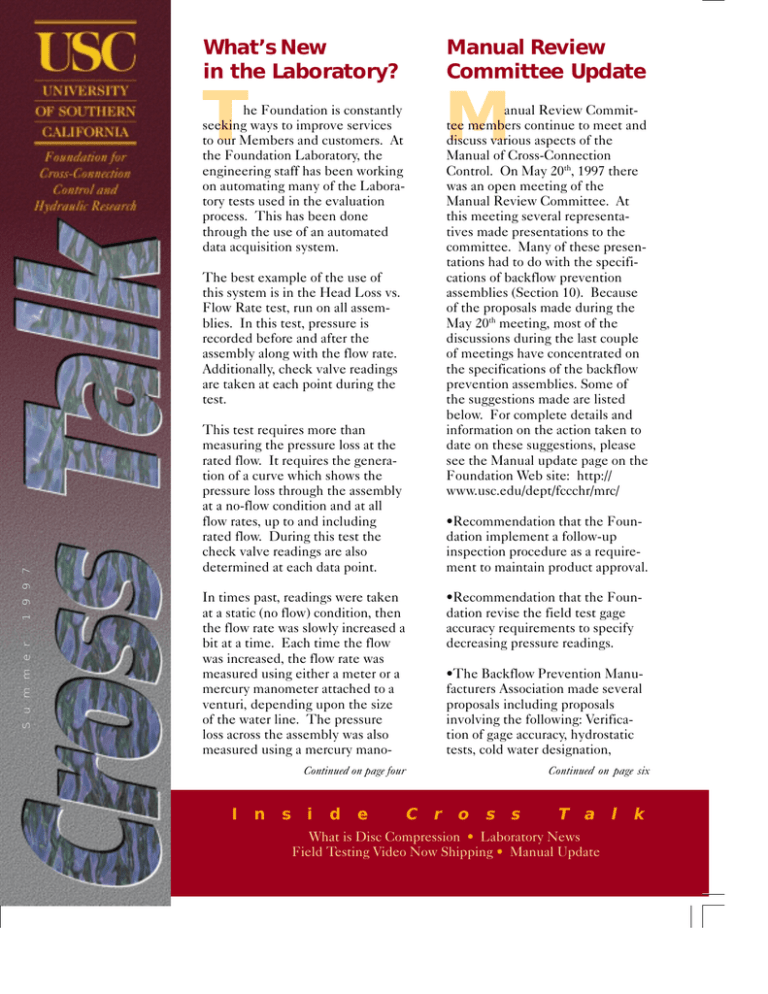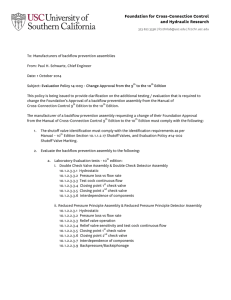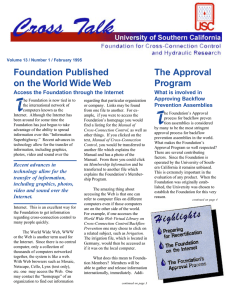T M What’s New Manual Review
advertisement

What’s New in the Laboratory? Manual Review Committee Update T M he Foundation is constantly seeking ways to improve services to our Members and customers. At the Foundation Laboratory, the engineering staff has been working on automating many of the Laboratory tests used in the evaluation process. This has been done through the use of an automated data acquisition system. anual Review Committee members continue to meet and discuss various aspects of the Manual of Cross-Connection Control. On May 20th, 1997 there was an open meeting of the Manual Review Committee. At this meeting several representatives made presentations to the committee. Many of these presentations had to do with the specifications of backflow prevention assemblies (Section 10). Because of the proposals made during the May 20th meeting, most of the discussions during the last couple of meetings have concentrated on the specifications of the backflow prevention assemblies. Some of the suggestions made are listed below. For complete details and information on the action taken to date on these suggestions, please see the Manual update page on the Foundation Web site: http:// www.usc.edu/dept/fccchr/mrc/ S u m m e r 1 9 9 7 The best example of the use of this system is in the Head Loss vs. Flow Rate test, run on all assemblies. In this test, pressure is recorded before and after the assembly along with the flow rate. Additionally, check valve readings are taken at each point during the test. This test requires more than measuring the pressure loss at the rated flow. It requires the generation of a curve which shows the pressure loss through the assembly at a no-flow condition and at all flow rates, up to and including rated flow. During this test the check valve readings are also determined at each data point. •Recommendation that the Foundation implement a follow-up inspection procedure as a requirement to maintain product approval. In times past, readings were taken at a static (no flow) condition, then the flow rate was slowly increased a bit at a time. Each time the flow was increased, the flow rate was measured using either a meter or a mercury manometer attached to a venturi, depending upon the size of the water line. The pressure loss across the assembly was also measured using a mercury mano- •Recommendation that the Foundation revise the field test gage accuracy requirements to specify decreasing pressure readings. •The Backflow Prevention Manufacturers Association made several proposals including proposals involving the following: Verification of gage accuracy, hydrostatic tests, cold water designation, Continued on page four I n s i d e Continued on page six C r o s s T a What is Disc Compression • Laboratory News Field Testing Video Now Shipping • Manual Update l k T Foundation Membership he Foundation’s Membership Program provides many benefits to the Members of the Foundation. These include: twenty percent discounts on Foundation Training courses for any employee of the Member company/ organization, the List of Approved Backflow Prevention Assemblies, printed quarterly, and access to the up-to-the-minute version of the List for those Members with Internet access. Members are encouraged to call the Foundation with technical questions. The Foundation’s Engineering Staff is available to assist Members with the various aspects of field testing backflow preventers, installing backflow preventers, administering their cross-connection control program. Two A-1 Utility & Construction Adams Testing Service Ames, City of Automatic Rain Company Avenal, City of Bristol-Myers Squibb Burnaby, City of CDM Federal Programs Chicago Backflow Crete, City of D.B. Barilla DynCorp Tri-Cities Services, Inc. Fawcett Contracting Fillo Mechanical, Inc. Four Way Water Supply Corp. John C. Scott Kathy Upp O’Leary Ketchum, City of Los Angeles Plumbing & Backflow Testing Michael R. Cleavinger Design & Engineering Pleasant Valley State Prison Plumbing Masters, Inc. Ralph Wituski Renco Sales Shafter, City of Stevens Maintenance Stinson Beach Maintenance Co. Stone-Drew/Ashe & Jones, Inc.Supreme Plumbing Terry’s Testing Truckee Meadows Community College Tumwater, City of Ziemer Plumbing, Inc Contacting the Foundation Mailing Address: Foundation for CrossConnection Control and Hydraulic Research University of Southern California Kaprielian Hall 200 Los Angeles, CA 90089-2531 Phone: 213 740 2032 FAX: 213 740 8399 e-mail: fccchr@usc.edu Web Site: www.usc.edu/dept/fccchr The Foundation accepts Purchase Orders via mail or fax and credit card orders (Visa, MasterCard, Discover) via telephone and the Web. Cross Talk is published by the Foundation for Cross-Connection Control and Hydraulic Research at the University of Southern California for Foundation Members. Limited additional copies are available to Members upon request. (213) 740-2032 1997 © University of Southern California. All rights reserved. What is Disc Compression? M any backflow prevention assembly testers use the term, disc compression. Although testers use the term disc compression and most understand that disc compression may be the cause of varied or false readings, many do not understand what disc compression is and how it can affect gage readings. One point that is important to understand when discussing disc compression is the fact that (at constant temperatures) pressure and volume are inversely proportional in ideal fluids. This means that as the pressure increases the volume decreases. If the pressure decreases, the volume increases. (NOTE: Although water is considered an incompressible fluid, for the purposes of backflow prevention assembly testing it does act as if it is compressible. This is due to tiny pockets or bubbles of air within the various regions of the backflow preventer. The air is actually compressing, giving the water the effects of compressing.) One of the most common observances of disc compression in the field test procedure is during the second check valve test on the reduced pressure principle assembly. During this test, high pressure is taken from the No. 2 test cock, bypassed through the gage and inserted behind the second check valve through the No. 4 test cock. This pressure can force the second check valve disc onto the seat of the second check valve. As the seat imbeds into the portion of the disc within the seat protrudes into the region between the two check valves. As this elastomer disc takes up more of the region between the check valves, the water (or air bubbles within the water) compresses, or is reduced in volume. This, in turn, causes the pressure to increase. As the pressure in the region between the two check valves increases, this increases the pressure at the No. 3 test cock. During the entire test of the reduced pressure principle assembly the high side of the gage is attached to the No. 2 test cock and the low side of the gage is attached to the No. 3 test cock and the gage is reading the difference between the two. When pressure at the No. continued on page six Although testers use the term disc compression and most understand that disc compression may be the cause of varied or false readings, many do not understand what disc compression is and how it can affect gage readings. Backpressure Three What’s New in the Laboratory continued from page one The system samples 10,000 points in a twelve second interval to determine the mode. meter along with the check valve readings. All of this was done at various rates of flow. In most cases the engineering staff uses at least fifteen data points as the flow rate increases and then fifteen more data points as the flow rate decreases. Once the thirty data points (minimum) are recorded, a bestfit curve is plotted. Adjustments must be made for the amount of piping between the pressure taps and the upstream and downstream flanges of the assembly. The pressure loss due to the piping is subtracted from the original data curve so that the curve shows only the pressure loss due exclusively to the assembly. This “corrected” curve is then the final flow curve for the specific size and model of assembly being tested. With the new data acquisition system, the procedure is much more simple. The equipment is attached to the piping to measure flow and pressure loss across the assembly. Pressure transducers are attached to the test cocks to determine check valve readings. The operator selects the type of assembly being tested, inputs the data on the assembly such as make model, etc. The size and orientation of the pipe is input and the system determines the correct calibration curve so that the corrected flow curve is generated automatically. Four As the flow rate is increased to each point the operator selects take reading. At this point the system samples 10,000 points in a twelve second interval to determine the mode (the most frequent value occurring in the set of 10,000 data points). Once the system makes these calculations a window indicates the corrected head loss, the flow rate, the check valve differentials, the line pressure and shows the flow curve of the readings taken. (See the window below.) Once the test is complete the system prints the flow curve, and the data points, if requested. The printed flow curve includes the differentiation of the raw data, corrected data, flow up and flow down as well as the first and second runs of the test. (The test is always run twice to confirm the data.) This overall procedure takes a fraction of the time and manpower it used to take before the data acquisition system was in place. With these types of improvements, the Foundation is able to conduct tests and get the corrected results in a much more timely fashion, increasing accuracy and proficiency in the Laboratory. With the data acquisition system, the overall procedure takes a fraction of the time and manpower it used to take before the system was in place. Five The Manual continued from page one Six If you would like to present information to the committee, or you would like to send suggestions for the committee’s consideration, please forward your request to the Foundation Office. removability of components, accessibility, differential pressure relief valve drain funnels, clearances, body and bonnet, size of test cocks, lubrication used on assemblies, changing minimum requirements for check valves, changing minimum requirements for the relief valve, and many other specific items. The proposal to change the minimum requirements for relief valve opening points specifically requested that the minimum relief valve opening point be changed from 2.0 psid to 1.0 psid. The Manual Review Committee would like to request any relief valve opening data from agencies with large databases of such information. Of specific interest is the change in relief valve opening point from year to year. In addition to the change in opening point over the first year, the committee would like data on the relief valve opening point the year after the reading is between 2.5 and 2.0 psid inclusive. If you have such data and would like to supply such information to the Manual Review Committee, please submit it to the Foundation Office. The Manual Review Committee welcomes comments and suggestions for any aspect of the Tenth Edition. The next open meeting of the Manual Review Committee is scheduled for 23 September 1997. If you would like to present information to the committee at this meeting, or you would like to send suggestions for the committee’s consideration, please forward your request with any substantiating material to the Foundation Office. Disc Compression continued from page three 3 test cock increases, this brings the pressure at the No. 3 test cock closer to the pressure at the No. 1 test cock. The difference between the two decreases, causing the gage reading to drop. Normally the drop in the gage reading is not significant, however, it is possible that the gage reading drop to the relief valve opening point. This is why it is necessary to bleed the low side of the gage again, even if the reading drops to the relief valve opening point. Bleeding the low side of the gage releases the pressure added by disc compression. Once the gage reading settles again, the gage reading is indicating the actually static pressure drop across the No. 1 check valve. The Video Field Testing Backflow Preventers, The video Field Testing Backflow Preventers clearly demonstrates the field test procedures for the double check valve assembly, the reduced pressure principle assembly and the pressure vacuum breaker assembly in accordance with the Ninth Edition of the Manual of Cross-Connection Control. Testing of a properly working assembly is included for each assembly, along with troubleshooting. The troubleshooting techniques are enhanced by the use of computer animation, which allows the viewer to see what is happening inside the assembly when external observations are made. For example, while testing a double check , one sees the water in the sight tube recede. The computer animation will show exactly where that water is going, thereby helping the tester remember what causes the receding water. The demonstration for the reduced pressure principle assembly includes methods using the two, three, and five needle valve gages. Seven The video is priced at $25.00 ($20.00 for Foundation Members). California Residents must add appropriate sales tax. Training Courses Tester Course Kansas City, MO 20-24 October 1997 Las Vegas, NV 17-21 November 1997 Los Angeles, CA 26-30 January 1998 Los Angeles, CA 4-8 May 1998 Los Angeles, CA 13-17 July 1998 Specialist Course Incline Village,NV 9-13 March 1998 Los Angeles, CA 20-24 July 1998 Upcoming Events American Backflow Prevention Association Board Meeting & Seminar •Vancouver, BC 5-6 September 1997 Inland Counties Water Association •San Bernardino, CA 10 September 1997 Manual Review Committee Open Meeting •Los Angeles, CA 23 September 1997 Northern California Backflow Prevention Association •Berkely, CA 2 October 1997 Western Regional ABPA •Las Vegas, NV 7-9 October 1997 San Antonio ABPA •San Antonio, TX 13-15 October 1997 CA/NV Section AWWA Fall Conference •Long Beach, CA 22 October 1997 Foundation for Cross-Connection Control and Hydraulic Research School of Engineering University of Southern California Kaprielian Hall 200 Los Angeles, California 90089-2531 First Class US Postage PAID University of Southern California


